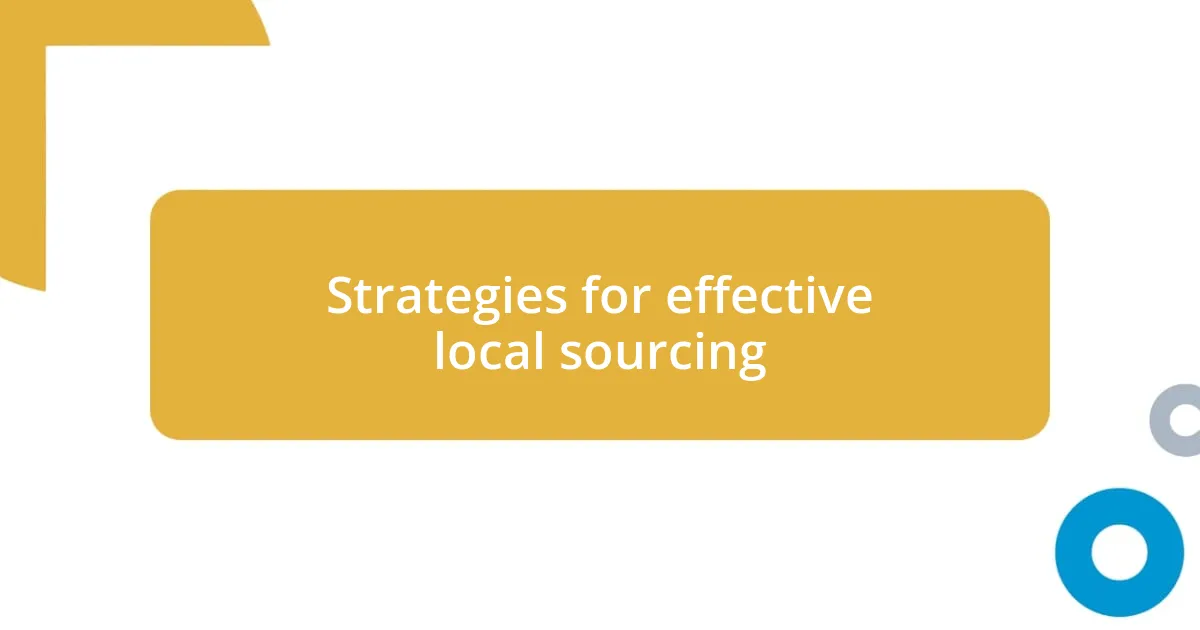Key takeaways:
- Local sourcing enhances design authenticity and fosters meaningful relationships with artisans, inspiring new creative ideas.
- Evaluating local materials involves considering durability, aesthetic appeal, sourcing stories, cost-effectiveness, and supplier relationships.
- Building trust and collaboration with local suppliers leads to innovation and community impact, enriching the design process.
- Overcoming challenges in local sourcing, such as limited options and quality variability, can lead to unexpected discoveries and deeper connections with the community.

Understanding local sourcing benefits
When I started exploring local sourcing in my design projects, I was genuinely surprised by the vibrant network of artisans and suppliers right in my community. Working closely with local craftspeople not only enhanced the authenticity of my designs but also fostered meaningful relationships that often inspire new creative ideas. Have you ever felt that spark of excitement when collaborating with someone who shares your vision? It’s a unique experience that truly enriches the creative process.
One undeniable benefit of local sourcing is the reduction of transportation costs and environmental impact. I remember a particular project where we sourced materials from just a few miles away, significantly lowering our carbon footprint. Each time I look at that design, I feel a sense of pride knowing that we made choices that were not only economically sound but also beneficial for our planet. Isn’t it rewarding to contribute to sustainability in a tangible way?
Additionally, local sourcing can also enhance community resilience. By choosing to work with local suppliers, I found that my designs echoed the cultural richness and stories of our region, creating a sense of local identity. It makes me wonder, how can we support and uplift our communities through our design choices? For me, it’s about embracing the unique qualities of our locality and weaving them into the fabric of our work.

Evaluating local materials options
Evaluating local material options requires a thoughtful approach that considers quality, availability, and cultural relevance. I remember visiting a local supplier who showcased reclaimed wood from old barns around the area. As I ran my hands over the weathered surface, the stories each piece could tell sparked my imagination. It became clear to me that choosing materials with a rich history didn’t just enhance my designs; it connected customers to their community in a way mass-produced materials never could.
When assessing local materials, here are some practical factors to consider:
- Durability: Are the materials weather-resistant and suitable for your project?
- Aesthetic Appeal: Does the look and feel of the materials align with your design vision?
- Sourcing Story: What is the backstory behind the materials, and how does it resonate with the local culture?
- Cost-Effectiveness: Are the expenses for local materials competitive, factoring in transportation savings?
- Supplier Relationships: Is the supplier reliable and willing to collaborate on custom requests?
Exploring these aspects not only enriches your design but can deepen your bond with the local community.

Building relationships with local suppliers
Building relationships with local suppliers has been one of the most rewarding aspects of my design journey. I vividly recall nearly missing out on a unique fabric because I hesitated to connect with a local vendor I had heard about. But once I reached out, not only did I discover a treasure trove of fabric options, but I also learned about the vendor’s passion for sustainable practices. It’s moments like these that truly highlight the power of personal connections in enhancing my projects.
Over time, nurturing these relationships has led to a level of trust that’s invaluable. I consider one specific supplier a true partner in my design process. On a project that involved custom furniture, I was able to collaborate directly with them to create pieces that perfectly matched my vision. The ability to communicate openly and make adjustments in real time is something I never take for granted. Have you experienced that moment when you realize you’re not just a customer but an integral part of a creative team?
There’s an unquantifiable value in building relationships with those who understand your design ethos. For instance, I once approached a local artisan known for his intricate metalwork, and through our discussions, we were able to incorporate elements into my design that told a story of our community’s history. Each design now carries a piece of that narrative, bridging the past with the present. The emotional connection I have with my suppliers has transformed my work into something that resonates more deeply with those who experience it.
| Aspect | Local Supplier Relationship |
|---|---|
| Trust | Built through consistent communication and collaboration. |
| Creativity | Inspires innovation through shared ideas and vision. |
| Community Impact | Supports the local economy and cultural identity. |

Incorporating local culture in design
Incorporating local culture in design can transform a project from being merely functional to truly meaningful. I once had the opportunity to design a community center that embraced the heritage of our town. By incorporating local motifs and color palettes inspired by the area’s landscape, the building became a gathering space that people genuinely connected to. Isn’t it fascinating how design can evoke a sense of pride and belonging?
As I explored the local art scene, I met a sculptor whose work was rooted in the community’s folklore. We decided to collaborate on a large installation for the center that depicted stories from our town’s history. Each piece we created together not only added visual interest but also invited visitors to engage with the narratives that shaped their environment. Have you ever felt the power of a story told through design? It can spark conversations and bring people together in unexpected ways.
The interplay of local culture in design often goes beyond just visual elements; it’s about creating an experience. I recall designing a coffee shop that featured locally sourced artwork and furniture, creating a space that celebrated local artists. Patrons felt like they were walking into a gallery infused with the essence of our town. It reminded me that when we honor the culture surrounding us, we invite others to become part of that story. How can we ensure that our designs reflect the heart of the community? By weaving local narratives into every detail.

Strategies for effective local sourcing
Establishing clear criteria for selecting local suppliers is a strategic approach I highly recommend. For instance, I always inquire not just about product quality but also about the supplier’s commitment to sustainability and ethical practices. Have you ever found that knowing a supplier shares your values makes your collaboration feel more purposeful? Each interaction becomes an extension of my design philosophy, ensuring that every material resonates with my ethical stance.
Another effective strategy I’ve employed is hosting workshops or open houses for local artisans. One memorable event I organized brought together various talents in our community, showcasing their crafts while fostering an atmosphere of collaboration. This not only enriched my design palette—with unique pieces that might typically go unnoticed—but also helped build a supportive network among local creators. I remember seeing the excitement on their faces when they realized how their work could contribute to a larger vision. Isn’t it gratifying to witness the synergy of creativity come alive in such environments?
Additionally, staying adaptable and open to feedback is crucial in local sourcing. On a recent project, I initially selected a particular wood type, but during discussions with a nearby supplier, we discovered a locally sourced alternative that offered a richer texture and story. Transforming challenges into opportunities has become a hallmark of my sourcing experience. Have you experienced that enlightening moment when a simple conversation leads to unexpected, creative breakthroughs? In my view, it’s these moments that make local sourcing not just a strategy but an enriching journey.

Overcoming challenges in local sourcing
When it comes to local sourcing, challenges like limited supplier options can initially feel daunting. I recall a project where I was set on using a particular material, but the local suppliers didn’t stock it. Instead of seeing it as a setback, I took the opportunity to explore alternatives and stumbled upon a lesser-known local material that not only met my needs but also told a unique story about our area. This shift taught me that sometimes, stepping outside of our comfort zones can lead to discoveries that enrich our designs.
One significant hurdle in local sourcing is the varying quality of materials provided by local suppliers. I’ve had my fair share of disappointments, particularly with artisanal woodwork that looked promising but didn’t hold up in use. What I’ve learned is the importance of building relationships with suppliers and setting expectations upfront. When I had a heart-to-heart conversation with a woodworker about my quality standards, he took it as a personal challenge. The next delivery was a showcase of craftsmanship, illustrating how honest dialogue can elevate the standards of local sourcing.
Another challenge I often encounter is the balance between local sourcing and budget constraints. In the early stages of my career, I was hesitant to pay a premium for locally produced items. However, as I invested in local artisans, I discovered that their craftsmanship brought a depth and uniqueness to my projects that wasn’t reflected in cheaper alternatives. Hasn’t there been a time when you realized that investing in quality pays off? In my experience, local sourcing may require more upfront investment, but the payoff in authenticity and community connection is invaluable.












